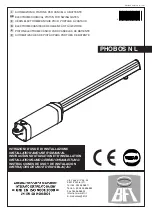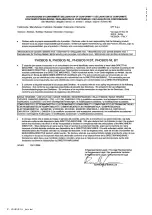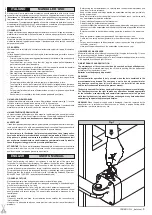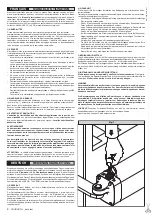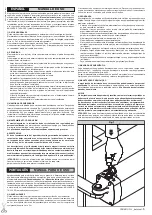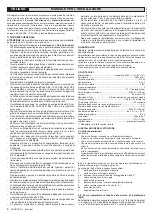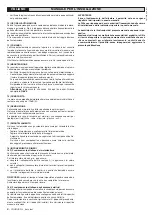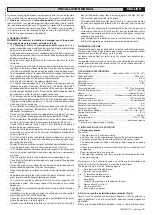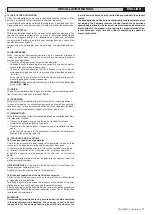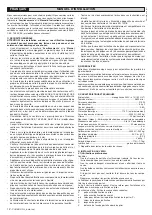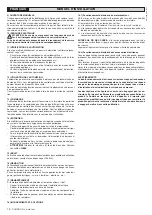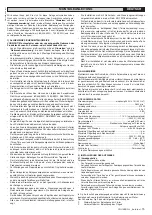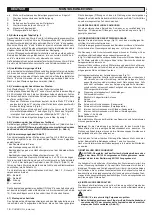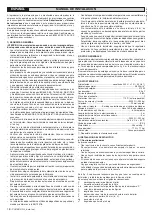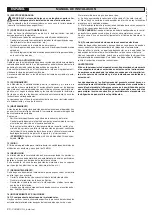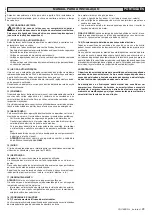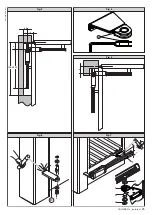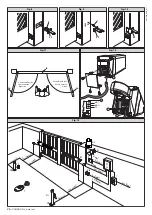
INSTALLATION MANUAL
ENGLISH
12) USE OF THE AUTOMATION
Since the automation may be remote controlled either by radio or a Start
button, it is essential that all safeties are checked frequently.
Any malfunction should be corrected immediately by a qualified specialist.
Keep children at a safe distance from the field of action of the automation.
13) THE CONTROLS
With the automation the gate has a power driven opening and closing. The
controls can come in various forms (i.e. manual, remote controlled, limited
access by magnetic badge, etc.) depending on needs and installation
characteristics. For details on the various command systems, consult the
specific instruction booklets.
Anyone using the automation must be instructed in its operation and con-
trols.
14) MAINTENANCE
When carrying out maintenance operation on the controller, disconnect
it from the mains power supply. The actuator does not require periodical
maintenance operations.
• Check the safety devices of the gate and automation.
• Periodically check the pushing force and correct the value of the electric
torque in the control board if necessary.
• In case of unsolved operation failures, disconnect the unit from the
mains power supply and ask for the intervention of qualified personnel
(installer).
When the unit is out of order, activate the manual release to perform
manual opening and closing manoeuvres.
•
WARNING!
Grease the worm screw every two years. Recommended
grease type:
G885
.
15) NOISE
The aerial noise produced by the gearmotor under normal operating condi-
tions is constant and does not exceed 70dB(A).
16) SCRAPPING
Materials must be disposed of in conformity with the current regulations.
In case of scrapping, the automation devices do not entail any particular
risks or danger. In case of recovered materials, these should be sorted out
by type (electrical components, copper, aluminium, plastic etc.).
17) DISMANTLING
When the automation system is disassembled to be reassembled on another
site, proceed as follows:
• Disconnect the power supply and the entire electrical installation.
• Remove the gearmotor from its fixing base.
• Disassemble the control panel, if separate, and all installation compo-
nents.
• In the case where some of the components cannot be removed or are
damaged, they must be replaced.
18) TROUBLES AND SOLUTIONS
18.1) Incorrect operation of gearmotor
Check for the presence of power supply to the gearmotor using a suitable
instrument after opening or closing commands have been given.
If the motor vibrates but does not turn, the causes could be the following:
a) incorrect connection of the C common wire, (it is always light blue).
b) operation capacitor not connected to the terminals on the control
board.
c) if the moving direction of the leaf is opposite to the right one, invert the
motor running connections.
LIMITING DEVICES:
If the time set on the control unit is insufficient, the
leaves might not complete their run.
Slightly increase the working time on the control unit.
18.2) Incorrect operation of the electrical accessories
All control and safety devices can cause, in case of failure, malfunctioning
or stoppage of the automation.
To identify the failure, it is advised to disconnect all the devices of the auto-
mation one by one until the one causing the problem is found.
After fixing or replacing the defective device, reset all the devices previously
disconnected. Refer to the relevant instruction manual for all the devices
installed on the automation.
WARNINGS
Correct controller operation is only ensured when the data contained
in the present manual are observed. The company is not to be held
responsible for any damage resulting from failure to observe the
installation standards
and the instructions contained in the present
manual.
The descriptions and illustrations contained in the present manual are
not binding. The Company reserves the right to make any alterations
deemed appropriate for the technical, manufacturing and commercial
improvement of the product, while leaving the essential product fea-
tures unchanged, at any time and without undertaking to update the
present publication.
PHOBOS N L _beta test -
11
D811609_beta test

